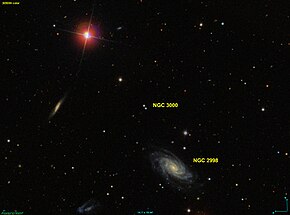NGC 3000 is a double star located in the constellation Ursa Major.[1] It was first discovered and observed by Bindon Stoney an assistant to William Parsons, on January 25, 1851,[2] and was initially catalogued as a nebula-like object. Since its discovery, NGC 3000 has been observed and studied using various telescopes.
| NGC 3000 | |
|---|---|
 NGC 3000 (center) | |
| Observation data (J2000 epoch) | |
| Constellation | Ursa Major |
| Right ascension | 09h 48m 51s |
| Declination | +44° 07’ 49” |
| Distance | 168 Mly (51.66 Mpc) |
| Apparent magnitude (V) | 10.88 |
| Apparent magnitude (B) | 11 |
| Characteristics | |
| Type | SB(r)bc |
| Notable features | N/A |
| Other designations | |
| PGC 5067534 | |
Discovery
editBindon Stoney first described NGC 3000 as a "very faint, small, irregularly round, mottled but not resolved" galaxy. However, its recorded position, precessed to RA 09 49 02.6, Dec +44 08 46, shows no object at that location. Analysis reveals Stoney's recorded positions for objects in this region consistently have a systematic error of approximately 2 arcminutes to the east-northeast. Applying this correction places the coordinates nearly precisely on a pair of stars now identified as NGC 3000.[3]
References
edit- ^ Ford, Dominic. "The New General Catalogue (NGC) in Ursa Major". In-The-Sky.org. Retrieved 2024-03-20.
- ^ "NGC 3000". spider.seds.org. Retrieved 2024-03-20.
- ^ "New General Catalog Objects: NGC 3000 - 3049". cseligman.com. Retrieved 2024-03-20.
External links
edit- Media related to NGC 3000 at Wikimedia Commons